The thread junkie in me is bubbling to the surface again!
Today, it’s bubbling up to show you a new-to-me silk thread that I’ve had a chance to play with recently. It’s Sajou’s Fil Au Chinois silk perle #30, and it’s… lovely. Deep Sigh.
Well, it’s silk – so what can I say?
I can’t resist trying new-to-me threads, examining them closely and seeing what they’re all about. I got these particular threads from Needle in a Haystack, where they’re newly listed on their website here.
If you’re a crazy quilter, a needlepointer, a cross stitcher, or a surface embroiderer, you’ll find plenty of good uses for a silk thread like this. It’s the kind of thread that’s hard to resist. It’s got a great sheen, it feels good, and, with a few little technical tips, it stitches up beautifully!
Let’s take a close look at it!

Fil Au Chinois Silk Perle #30, which I’m going to refer to hereafter as Sajou’s silk perle, is available in a small range of 30 colors that are fairly classic, with a few bright, trendy colors in the mix, too.
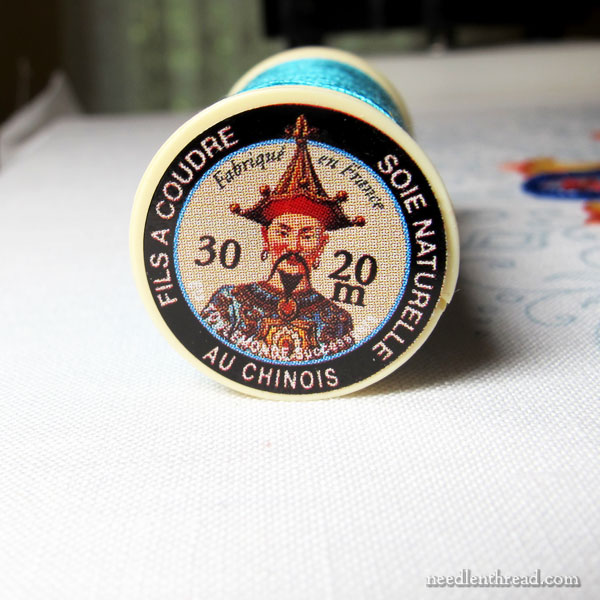
The thread comes on 20 meter spools. They’re nice-sized spools which have, as is typical of Sajou, a kind of vintage look to them.
The Fil a Chinois label has a bit of a history to it. You can read about it on the Sajou website, here. In fact, the Sajou blog (Madame Sajou’s Diary) is terrific to read and has lots of nice tips and ideas on it, if you’re looking for a generally fun browse.

To give you an idea of the weight of the thread, here it is (in turquoise) lined up next to one strand of DMC cotton (in peach).
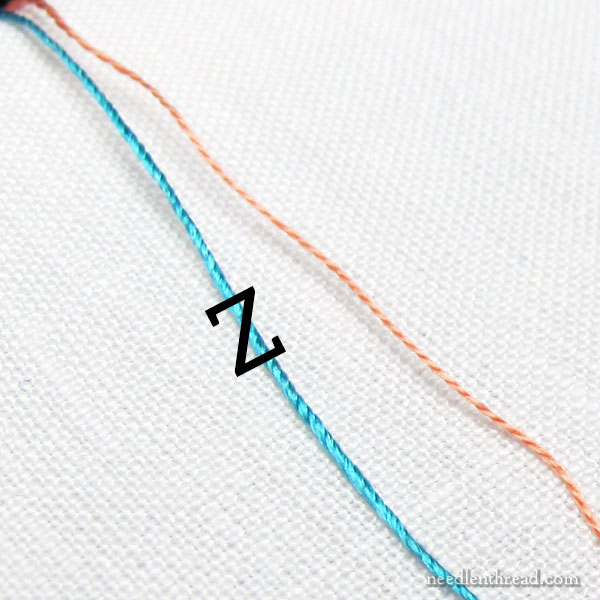
Sajou’s silk perle is a z-twisted, 3-ply filament silk.
In a nutshell, the z-twist is important to know about because it requires a different approach on some embroidery stitches. Most common hand embroidery threads – cottons, stranded spun silks, for example – are s-twisted, and most embroidery instructions are written assuming the use of s-twisted threads.If you’re not familiar with the difference between s-twisted threads and z-twisted threads, you can read about the differences in the following articles:
S-Twisted vs Z-Twisted Threads
S-Twisted vs Z-Twisted Threads, Stitched
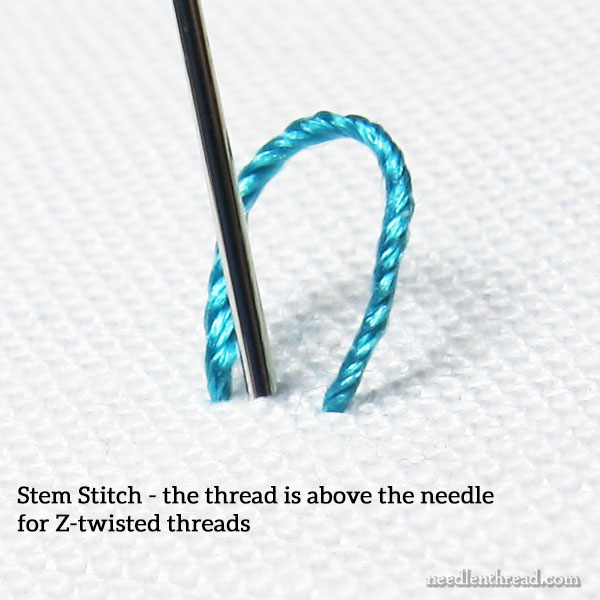
The biggest difference between s-twisted threads (like typical cotton embroidery floss) and z-twisted threads (like some silks and pretty much all rayons) is found in stitches that are meant to twist together, like stem stitch, or in stitches that require winding the thread around the needle multiple times, like bullion knots.
With the stem stitch, when stitching from left to right, the working thread is normally kept below the needle when you’re stitching with cotton. That’s how most people do stem stitch. But with a z-twisted thread like this silk perle, if I want to maintain the ropey look of the stem stitch, I have to work it from left to right with the working thread above the needle.
In any case, if you don’t use rayons or silks like these, the point it rather moot. You don’t need to worry about z-twist and s-twist. But if you’re venturing into new types of threads, it’s worth paying attention to the twist of the thread.
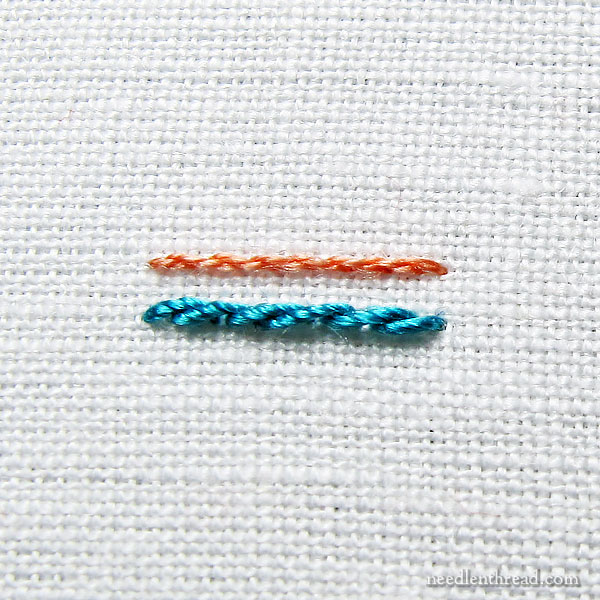
To give you a clear idea of the weight of this silk, the top line is stem stitch in one strand of DMC floss (taken from the six). And on the bottom is a line of stem stitch worked with the silk perle.
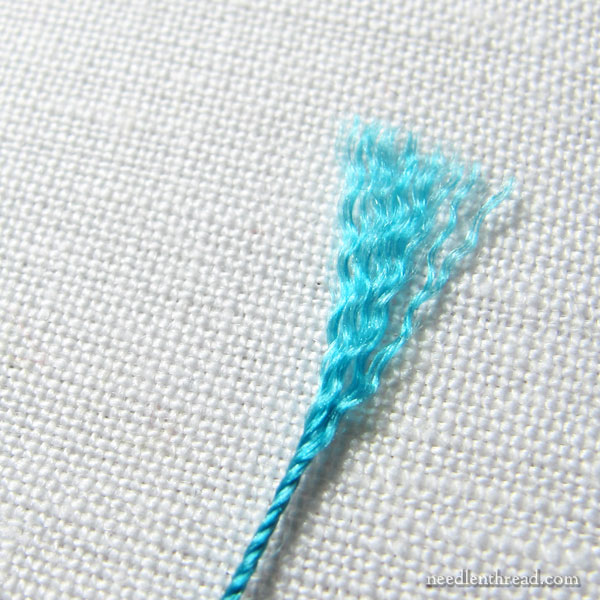
Incidentally, because Sajou’s silk perle is filament silk, it can be taken apart and used, since strands of filament silk are very strong and don’t really need a twist to keep their strength intact.
However, taking apart this type of thread can be amazingly fiddly! When taken apart, the thread will have a definite wave to it, as you can see in the photo above, due to the twist. Sometimes, you can play with that to get some interesting effects in stitching. But again – super fiddly!
Compared to Soie Perlee
Sajou’s silk perle lines up in type and weight quite near to Au Ver a Soie’s Soie Perlee. Soie Perlee comes on smaller spools of 14 meters, but they have a much more extensive color range and the spools are priced comparable to the amount of thread on them.
If you want to read more about Soie Perlee, I covered it in this article on Twisted Filament Silks.
Where to Find It
So, if you’re a thread junkie like me and you want to give this silk perle a try, here’s where you can find it:
If you’re in the States, you can find Fil a Chinois silk perle #30 through Needle in a Haystack.
I don’t know of any other shop carrying the Sajou silk threads in the US, but if you know of any, let me know! If you’re looking for other Sajou goodies in the US, you’ll find Sajou charts and kits available through French Needle, here.
Overseas, you can find Sajou threads directly through Sajou in France, if you don’t have a local store that carries them.
Looking for More Thread Talk?
If you get excited about embroidery threads, if you want to know more about different types of hand embroidery threads available on the market today, or you’re a thread junkie, too, and just want to read about threads in general, you’ll find plenty of other articles about embroidery threads here on Needle ‘n Thread. Have a browse!
Hope you enjoy your weekend and get in plenty of time with your needle and thread!







